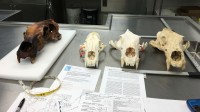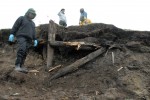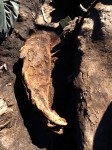 A huge polar bear skull with very different features from modern polar bear skulls has been discovered at an eroding archaeological site in northernmost Alaska. Its massive size and elongated, narrow shape recall an unusual polar bear reported by Inuit hunters but never photographed, filmed or in any other way scientifically verified.
A huge polar bear skull with very different features from modern polar bear skulls has been discovered at an eroding archaeological site in northernmost Alaska. Its massive size and elongated, narrow shape recall an unusual polar bear reported by Inuit hunters but never photographed, filmed or in any other way scientifically verified.
In interview projects documenting the traditional knowledge of the Inuit peoples of northern Alaska and the western Canadian Arctic, hunters report very rare sightings of a bear “that has a longer neck; it’s high and pure white, but looks like a weasel and runs fast like a weasel”. This creature is known as “tiriarnaq” in the Siglitun dialect, “tigiaqpak” in the Kangiryuarmiut dialect, all of them translating to “weasel bear.”
Here’s a description of a weasel bear by a Sachs Harbour hunter from a 2010 interview:
“You get sometimes bears which we call tiriarnat, and they get over 11 foot. They get very big; they’re slim, their necks are way longer than the stubby bears that we get now. I never seen a weasel type bear for years, years and years…. We used to see some north of Storkerson Bay when we travel…. And they’re very big…. Stubby bears get ten [feet] three [inches], ten [feet] four [inches], that sort of thing. But a weasel type bear is 11-foot plus.
There are differences between some of the accounts of the weasel bear — some say they’re fat, not slender, others say they’re all male — but the large, long, narrow head and neck is common to all the stories. The recently discovered skull fits the description.
“It looks different from your average polar bear,” said Anne Jensen, an Utqiaġvik-based archaeologist who has been leading excavation and research programs in the region.
Through radiocarbon dating and subsequent analysis, Jensen and her colleagues estimate that the big bear skull — which appears to be the fourth largest ever found — is from a period between the years 670 and 800. It is possibly the oldest complete polar bear skull found in Alaska, inspiring a name for the departed creature that owned it: The Old One.
Exactly what accounts for its differences is yet to be determined; genetic testing is needed for that, Jensen said. It could have been a member of a subspecies or a member of a different “race” in genetic terms — similar to the varying breeds that are found among dogs — or possibly something else entirely, said Jensen, who works for the science department of the Native village corporation, Ukpeaġvik Iñupiat Corp., or UIC.

The rapid thawing of the permafrost on the Chukchi Sea coast has exposed the archaeological site of Walakpa, 13 miles southwest of Utqiaġvik (the northernmost city in the United States formerly known as Barrow). First excavated by Smithsonian anthropologist Dennis Stanford in the late 1960s when the permafrost was still perma, Walakpa is a settlement from the Birnirk period (600-1300 A.D.). It was widely believed to have been so thoroughly explored by Stanford’s team that there were no archaeological materials of note left to discover.
 Climate change proved that consensus wrong in the late summer of 2013 when the face of a bluff sheered off after a storm, exposing the timbers of an ancient house. They could not be fully excavated due to adverse environmental conditions and lack of funding. In 2014, a 90-foot section of soil collapsed. A local discovered the polar bear skull at that time, although exactly where and when is unclear.
Climate change proved that consensus wrong in the late summer of 2013 when the face of a bluff sheered off after a storm, exposing the timbers of an ancient house. They could not be fully excavated due to adverse environmental conditions and lack of funding. In 2014, a 90-foot section of soil collapsed. A local discovered the polar bear skull at that time, although exactly where and when is unclear.
 Anne Jensen was finally able to raise the funds for a solid three-week dig last summer. The exposed timbers were lost by then, but Jensen’s team unearthed a number of artifacts and remains preserved for centuries in the permafrost and recovered before their decay was accelerated by the warming soil. The sheered-off bluff where the timers were found still harbored a rare treasure: four mummified seals, naturally preserved in what had once been an ice cellar. These are the only mummified seals ever found outside of the McMurdo Dry Valleys of Antarctica. Jensen excavated one of them, a female dubbed Patou dating to the mid-1940s whose body is intact from fur to claws.
Anne Jensen was finally able to raise the funds for a solid three-week dig last summer. The exposed timbers were lost by then, but Jensen’s team unearthed a number of artifacts and remains preserved for centuries in the permafrost and recovered before their decay was accelerated by the warming soil. The sheered-off bluff where the timers were found still harbored a rare treasure: four mummified seals, naturally preserved in what had once been an ice cellar. These are the only mummified seals ever found outside of the McMurdo Dry Valleys of Antarctica. Jensen excavated one of them, a female dubbed Patou dating to the mid-1940s whose body is intact from fur to claws.
Time is running out for this site and many others in Alaska, and funding hasn’t come to close to keeping up with the pace of site deterioration.
The good condition of the artifacts is only temporary. As thaw and erosion occurs, items fall into the sea or, if exposed to the air, are at risk of decay.
Even if they are not exposed to air, artifacts can be vulnerable to below-ground degradation, Jensen said. As soils warm, bacteria are better able to decompose bones and other items. Even worse, warming soils can bring the items to a point where they generate their own heat, speeding the decomposition process.
With open water present up to eight months of the year instead of two and with temperatures rising and shorelines crumbling, the threats to the archaeological sites are increasing exponentially, Jensen said. Sites are eroding at a rate that far outpaces the normal grant process used to secure funding for work, and some new emergency approach is probably warranted, she said.
“It’s like the library is essentially on fire — now,” she said.
Do they know if “Tiriarnaq“, the ’11-foot plus’ wolverine ‘in pure white that looks and runs fast like a weasel’, swims like a polar bear would ? Once, I saw a Grizzly being filmed from a helicopter hunting down a deer with a -rather frightening- sprint of ~5 kilometers :skull:
However, an ‘Arctic Sea Ice Minimum Comparison (2012-1984)’ illustrates why polar bears in central Canada are better off than their peers in Svalbard or Russia, where some of them starve to death or simply drown, and why Alaska is affected.
A polar bear habitat projection is available from here. Where there is no ice when they need it most, they obviously seem to have a problem.
The Inuit have a story about large polar bear that spends most of it’s time on the ice and in the water hunting that is said to be bigger than average, with some of the claims bordering on the outlandish, quick moving thirty feet long bears that capsize umiaks and take the hunters on board.
I wonder if the weasel bear is the root of these stories?